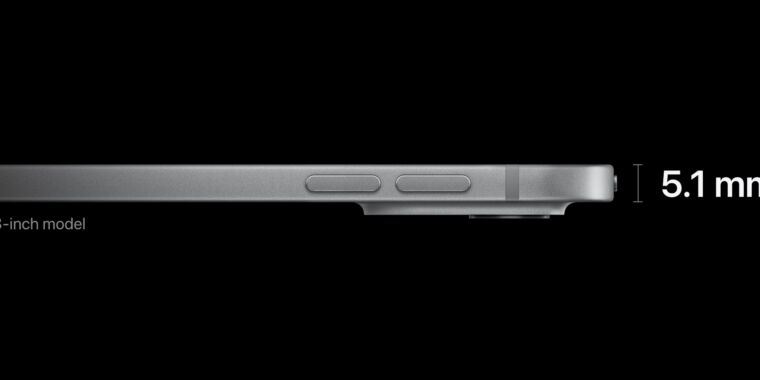Apple
Though Apple has a reputation for prioritizing thinness in its hardware designs, the company has actually spent the last few years learning to embrace a little extra size and/or weight in its hardware. The Apple Silicon MacBook Pro designs are both thicker and heavier than the Intel-era MacBook Pros they replaced. The MacBook Air gave up its distinctive taper. Even the iPhone 15 Pro was a shade thicker than its predecessor.
But Apple is apparently planning to return to emphasizing thinness in its devices, according to reporting from Bloomberg’s Mark Gurman (in a piece that is otherwise mostly about Apple’s phased rollout of the AI-powered features it announced at its Worldwide Developers Conference last week).
Gurman’s sources say that Apple is planning “a significantly skinnier iPhone in time for the iPhone 17 line in 2025,” which presumably means that we can expect the iPhone 16 to continue in the same vein as current iPhone 15 models. The Apple Watch and MacBook Pro are also apparently on the list of devices Apple is trying to make thinner.
Apple previewed this strategy with the introduction of the M4 iPad Pro a couple of months ago, which looked a lot like the previous-generation iPad Pro design but was a few hundredths of an inch thinner and (especially for the 13-inch model) noticeably lighter than before. Gurman says the new iPad Pro is “the beginning of a new class of Apple devices that should be the thinnest and lightest products in their categories across the whole tech industry.”
Thin-first design isn’t an inherently good or bad thing, but the issue in Apple’s case is that it has occasionally come at the expense of other more desirable features. A thinner device has less room for cooling hardware like fans and heatsinks, less room for batteries, and less room to fit ports.
The late-2010s-era MacBook Pro and Air redesigns were probably the nadir of this thin-first design, switching to all-Thunderbolt ports and a stiff-feeling butterfly switch keyboard design that also ended up being so breakage-prone that it spawned a long-running Apple repair program and a class-action lawsuit that the company settled. The 2020 and 2021 MacBooks reversed course on both decisions, reverting to a more traditional scissor-switch keyboard and restoring larger ports like MagSafe and HDMI.
Hopefully, Apple has learned the lessons of the last decade or so and is planning not to give up features people like just so it can craft thinner hardware. The new iPad Pros are a reason for optimism—they don’t really give up anything relative to older iPad models while still improving performance and screen quality. But iPad hardware is inherently more minimalist than the Mac and is less space-constrained than an iPhone or an Apple Watch. Here’s hoping Apple has figured out how to make a thinner, lighter Mac without giving up ports or keyboard quality or a thinner, lighter iPhone or Apple Watch without hurting battery life.

